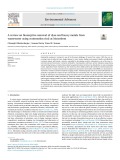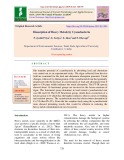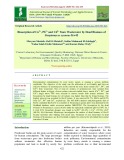
Biosorption of heavy metals
-
The presence of heavy metals pollutants in the industrial effluents has become a serious problem for human beings and the environment. In this work, chitosan beads were crosslinked and modified by Saccharomyces cerevisiae (S. cerevisiae) and histidine to enhance its acid stability and mechanical strength and biosorption capacity.
 5p
5p  vidoctorstrange
vidoctorstrange
 06-05-2023
06-05-2023
 3
3
 2
2
 Download
Download
-
(BQ) Ebook Mycoremediation: Fungal bioremediation – Part 2 presents the following content: Fungal metabolism of polycyclic aromatic hydrocarbons; fungal lignin degradation and decolorization of pulp and paper mill effluents; fungal decolorization and degradation of dyes; fungal biosorption of heavy metals; mycorrhizal fungi in rhizosphere remediation.
 310p
310p  runordie7
runordie7
 30-08-2022
30-08-2022
 13
13
 2
2
 Download
Download
-
This paper reviews the various important aspects of utilization of watermelon rind as a biosorbent for removing dyes and heavy metals from contaminated water. The effects of several factors such as pH, initial solute concentration, biosorbent dose, co-solute concentration, activation etc. has been reviewed in this paper.
 13p
13p  thebadguys
thebadguys
 15-01-2022
15-01-2022
 10
10
 0
0
 Download
Download
-
The highest number and percentage of isolates were obtained from tri-phosphate fertilizer and rock phosphate samples (9 isolates with 34.6% for each sample) and then 8 isolates with 30.8% from monophosphate fertilizer.
 7p
7p  schindler
schindler
 30-12-2021
30-12-2021
 10
10
 0
0
 Download
Download
-
Persistent heavy metal pollution poses a major threat to all life forms in the environment due to its toxic effects. These metals are very reactive at low concentrations and can accumulate in the food web, causing severe public health concerns. The use of microbial biosorbents is eco-friendly and cost effective; hence, it is an efficient alternative for the remediation of heavy metal contaminated environments.
 17p
17p  trinhthamhodang1215
trinhthamhodang1215
 23-09-2020
23-09-2020
 15
15
 1
1
 Download
Download
-
Bio sorption potential of cyanobacteria in absorbing lead and chromium was carried out as an experimental study. The algae collected from the rice field are examined for the lead and chromium absorption potential. Visual changes, followed by disintegration of the cyanobacterial mat had gradually progressed with the increase in concentration of lead and chromium from 0 ppm to 150 ppm which indicates the metal absorption.
 10p
10p  nguaconbaynhay4
nguaconbaynhay4
 22-03-2020
22-03-2020
 8
8
 2
2
 Download
Download
-
Environmental contamination by toxic heavy metals is causing a serious problem worldwide. The objective of the study was the utilization of eco-friendly and low-cost effective biomass of actinomycetes in the removal the toxic heavy metals (Cu2+, Pb2+, and Cd2+) from wastewater. Out of sixty-six isolates of actinomycetes were isolated from different drains in Egypt, eleven isolates removed studied heavy metals (Cu2+, Pb2+, and Cd2+) singly above 70% were selected to remove metals from ternary mixtures. The biosorption by dead biomass for all isolates was higher than that by living biomass.
 14p
14p  nguaconbaynhay3
nguaconbaynhay3
 07-02-2020
07-02-2020
 11
11
 0
0
 Download
Download
-
Biosorption of cadmium and lead from aqueous solution by fresh water alga Anabaena sphaerica biomass
The present work represents the biosorption of Cd(II) and Pb(II) from aqueous solution onto the biomass of the blue green alga Anabaena sphaerica as a function of pH, biosorbent dosage, contact time, and initial metal ion concentrations. Freundlich, Langmuir, and Dubinin–Radushkevich (D–R) models were applied to describe the biosorption isotherm of both metals by A. sphaerica biomass. The biosorption isotherms studies indicated that the biosorption of Cd(II) and Pb(II) follows the Langmuir and Freundlish models. The maximum biosorption capacities (qmax) were 111.1 and 121.
 8p
8p  kethamoi1
kethamoi1
 17-11-2019
17-11-2019
 19
19
 1
1
 Download
Download
CHỦ ĐỀ BẠN MUỐN TÌM




















